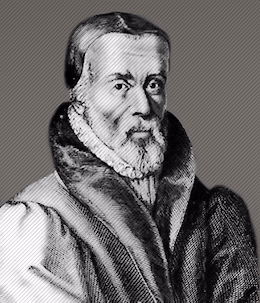Textus Receptus Bibles
William Tyndale Bible 1534
New Testament
| 13:1 | And I sawe a best rise out of the see havinge vii. heddes and x. hornes and apon hys hornes x. crownes and apon his heed the name of blasphemy. |
| 13:2 | And the beast which I sawe was lyke a catt of the mountayne and his fete were as the fete of a bear and his mouth as the mouthe of a lyon. And the dragon gave him his power and his seate and grett auctorite: |
| 13:3 | and I sawe one of his heedes as it were wouded to deth and his dedly woude was healed. And all the worlde wondred at the beast |
| 13:4 | and they worshipped ye drago which gave power vnto the beest and they worshipped the beest sayinge: who is lyke vnto the beast? who is able to warre with him? |
| 13:5 | And ther was a mouth geve vnto him that spake great thinges and blasphemies and power was geve vnto him to do xlii. Monethes |
| 13:6 | And he opened his mowth vnto blasphemy agaynst God to blaspheme hys name and his tabernacle and them that dwell in heven. |
| 13:7 | And it was geven vnto him to make warre with the saynctes and to overcome them. And power was geven him over all kynred tonge and nacion: |
| 13:8 | and all that dwell apon the erth worshipt him: whose names are not written in the boke of lyfe of the lambe which was kylled from the begynnynge of the worlde. |
| 13:9 | Yf eny man have an eare lett him heare. |
| 13:10 | He that leadeth into captivite shall goo into captivite: he that kylleth with a swearde must be kylled with a swearde. Heare is the pacience and the fayth of the saynctes. |
| 13:11 | And I behelde another best commynge vp oute of the erth and he had two hornes like a lambe and he spake as dyd the dragon. |
| 13:12 | And he dyd all that the fyrste beest coulde do in his presence and he caused the erth and them which dwell therin to worshippe the fyrst beest whose dedly woude was healed. |
| 13:13 | And he dyd grett wonders so that he made fyre come doune from heven in the syght of men. |
| 13:14 | And deceaved them that dwelt on the erth by the meanes of those signes which he had power to doo in the sight of the beest sayinge to the that dwelt on the erth: that they shuld make an ymage vnto the beest which had the woude of a swearde and dyd lyve. |
| 13:15 | And he had power to geve a sprete vnto the ymage of the beest and that the ymage of the beest shuld speake and shuld cause that as many as wolde not worshyppe the ymage of the beest shuld be kylled. |
| 13:16 | And he made all bothe smale and grett ryche and poore fre and bond to receave a marke in their right hondes or in their forheddes. |
| 13:17 | And that no ma myght by or sell save he that had the marke or the name of the beest other the nombre of his name. |
| 13:18 | Here is wisdome. Let him that hath wytt count the nombre of the beest. For it is the nombre of a man and his nombre is sixe hondred threscore and sixe. |

William Tyndale Bible 1534
William Tyndale was the first man to ever print the New Testament in the English language. Tyndale also went on to be the first to translate much of the Old Testament from the original Hebrew into English, but he was executed in 1536 for the "crime" of printing the scriptures in English before he could personally complete the printing of an entire Bible. His friends Myles Coverdale, and John [Thomas Matthew] Rogers, managed to evade arrest and publish entire Bibles in the English language for the first time, and within one year of Tyndale's death. These Bibles were primarily the work of William Tyndale.